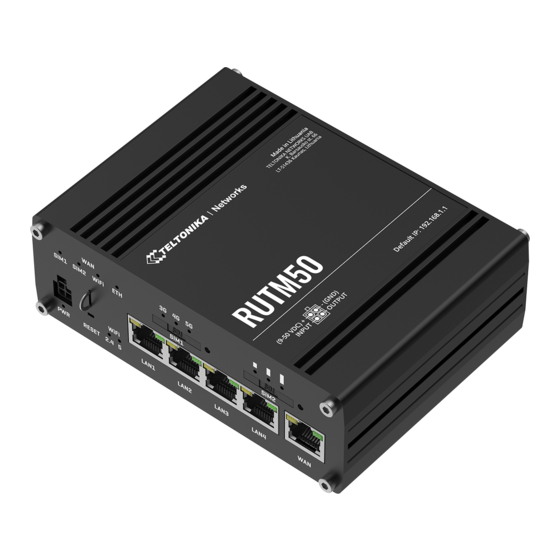
Table of Contents
Advertisement
Quick Links
https://wiki.teltonika-networks.com/view/QSG_RUTM50
QSG RUTM50
Main Page
>
RUTM Routers
This Wiki page contains the online version of the Quick Start Guide (QSG) for the RUTM50 5G
Router. Here you will find an overview of the various components on the front and back of a
RUTM50 device, hardware installation instructions, first login information, device specifications, and
general safety information. It is highly recommended to acquaint yourself with the Quick Start Guide
before using the device. You can also locate a printed version of the Quick Start Guide in the
packaging box of your device.
Contents
•
1 Safety information
-
1.1 General
-
-
-
-
-
•
•
•
•
•
•
•
•
•
Safety information
Before starting operating the device, please review recommendations and precautions to minimize
the possibility of accidents. Safety precautions presented are supplementary and subject to the local
safety regulations. When various operations are executed on the device, the user must fully follow
the safety instructions and recommendations provided with the device.
General
RF technologies GNSS/4G/5G/Wi-Fi
Max RF power 23 dBm@LTE, 23 dBm@5G, 20 dBm@WiFi 2.4G, 23 dBm@WiFi 5G
Power adapter Input: 0.6A@100-240 VAC, Output: 12 VDC, 1.5A, 4-pin plug
617~960 / 1710~2690 / 3300~6000 MHz, 50 Ω, VSWR<3, gain** 4 dBi,
Mobile antenna
omnidirectional, SMA male connector
>
RUTM50
> QSG RUTM50
Radio specifications
Bundled accessories specifications*
Advertisement
Table of Contents

Subscribe to Our Youtube Channel
Summary of Contents for Teltonika QSG RUTM50
-
Page 1: Table Of Contents
> RUTM50 > QSG RUTM50 This Wiki page contains the online version of the Quick Start Guide (QSG) for the RUTM50 5G Router. Here you will find an overview of the various components on the front and back of a RUTM50 device, hardware installation instructions, first login information, device specifications, and general safety information. - Page 2 1575.42~1602 MHz, 2.2~5 VDC, VSWR<1.5, active total gain** 28 dB (typ.), GNSS antenna RHCP polarization, SMA male connector 2400~2500 /4950~5850 MHz, 50Ω, VSWR<2, gain** 3dBi, omnidirectional, RP- WiFi antenna SMA male connector * Order code dependant. ** Higher gain antenna can be connected to compensate for cable attenuation when a cable is used. The user is responsible for the compliance with the legal regulations.
-
Page 3: Rf Exposure
L'appareil doit accepter tout brouillage radioélectrique subi, mźme si le brouillage est. Detailed compliance information is available at the following internet address: wiki.teltonika- networks.com/view/Certificates. This sign means that is necessary to read the User's Manual before you start using the device. -
Page 4: Operating Conditions
This radio transmitter IC: 26511-RUTM50 has been approved by Innovation, Science and Economic Development Canada to operate with the antenna types listed below, with the maximum permissible gain indicated. Antenna types not included in this list that have a gain greater than the maximum gain indicated for any type listed are strictly prohibited for use with this device. -
Page 5: Faulty And Damaged Products
Out of direct sunlight Away from heat source, corrosive substances, salts, and flammable gases Attention: operation outside the permissible range can considerably shorten the service life of the device. Faulty and damaged products Do not attempt to disassemble the device or its accessories. Only qualified personnel must service or repair the device or its accessories. -
Page 6: Front View
POWER SOCKET PINOUT Video Quick Start Guide Need some help setting up your new Teltonika Networks RUTM50 Industrial 5G Router? Watch our quick start guide video and follow the step by step instructions to easily set up your new router for... -
Page 7: Hardware Installation
Hardware installation Configure your computer LAN (Windows) 1. Ensure the Network connection is Enabled. Go to Start — Control Panel — Network and Internet — Network and Sharing Center. Click on the Change adapter settings in the left panel, then right-click on Network Adapter, and... -
Page 8: Configure Your Computer Wi-Fi (Windows)
2. Check if IP and DNS are obtained automatically. Right-click on Wireless Network Adapter and select Properties. Then select Internet Protocol Version 4 and click Properties. 3. If not selected, check to obtain an IP address and obtain DNS server address automatically. -
Page 9: Login To Device
2. Check if IP and DNS are obtained automatically. Right-click on Wireless Network Adapter and select Properties. Then select Internet Protocol Version 4 and click Properties. 3. If not selected, check to obtain an IP address and obtain DNS server address automatically. - Page 10 1. To enter the router's Web interface (WebUI), type http://192.168.1.1 into the URL field of your Internet browser. 2. When prompted for authentication enter the username admin and enter the password located on the device information label/engraving.
-
Page 11: Sim Card Recommendations
3. After logging in, you must set a new password for security reasons. You will not be able to interact with the router’s WebUI until the default password is changed. The new password must consist of a minimum of 8 characters.















Need help?
Do you have a question about the QSG RUTM50 and is the answer not in the manual?
Questions and answers